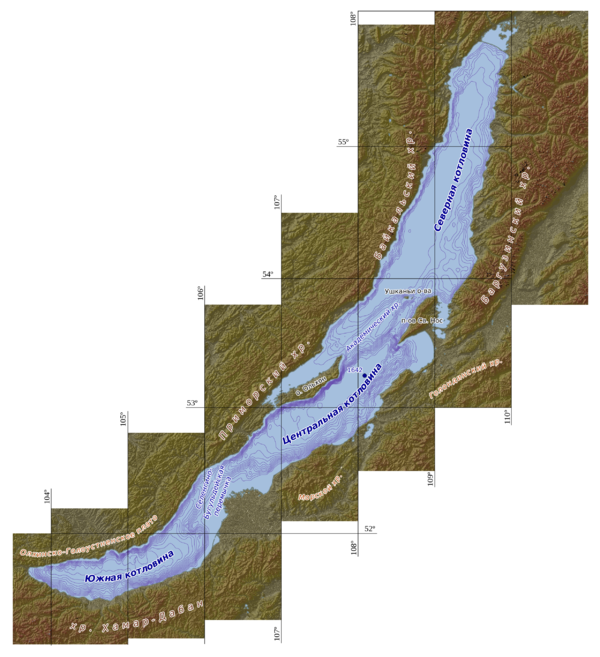Academician Ridge
Academician Ridge represents a unique sedimentary environment within Lake Baikal. The depths of the two basins it separates, about 900 m in the North Basin and about 1600 m deep in the Central basin, isolate the ridge from mass-flows and turbidites. Therefore, sedimentation on Academician Ridge is restricted to fine, continuous hemipelagic sedimentation with dispersed coarse-grained sediment deposited by ice rafting (Kuzmin et al., 2000). The stratigraphy observed in boreholes drilled into Academician Ridge shows that the upper sequence of continuous hemipelagic deposits, which are consistent with a bathymetric high in a deep lacustrine environment, is underlain by a lower sequence that is consistent with prograding, deltaic deposits in a shallow-water environment (Mats et al., 2000). This change from a shallow-water environment to a deep-water environment represents two things: one, that Academician Ridge experienced gradual flooding and, two, that the presence of a lake in the North Basin occurred long after the presence of a lake in the Central and South basins first occurred (Mats et al., 2000).
Academician Ridge also plays an important role in deep-water mixing processes and the circulation of bottom currents. Water with a higher salinity than the lake is fed to the Central Basin by the Selenga River. In contrast, the Upper Angara River feeds the North Basin with fresh water. The result is dense, more saline surface waters from the Central Basin flowing northeast and passing over Academician Ridge into the less dense, less saline waters of the North Basin. The saline surface water then sinks along the density gradient to replenish the deep bottom waters of the North Basin (Francus and Karabanov, 2000; Colman et al., 2003).
Timeline of Major Events
| Late Oligocene-Early Miocene | formation of a deep lake in the South and Central Basins |
| Middle-Late Miocene | uplift and formation of Academician Ridge |
| Late Miocene | gradual flooding of Academician Ridge |
| latest Pleistocene | complete submergence of Academician Ridge |
References
- Colman, S.M.; Karabanov, E.B.; Nelson III, C.H. (2003). "Quaternary sedimentation and subsidence history of Lake Baikal, Siberia, based on seismic stratigraphy and coring". Journal of Sedimentary Research. 73 (6): 941–956. Bibcode:2003JSedR..73..941C. doi:10.1306/041703730941. S2CID 129172990.
- Francus, P.; Karabanov, E.B. (2000). "A computer-assisted thin-section study of Lake Baikal sediments: a tool for understanding sedimentary processes and deciphering their climatic signal". International Journal of Earth Sciences. 89 (2): 260–267. Bibcode:2000IJEaS..89..260F. doi:10.1007/s005319900064. S2CID 15825448.
- Hutchinson, D.R.; Golmshtok, A.J.; Zonenshain, L.P.; Moore, T.C.; Scholz, C.A.; Klitgord, K.D. (1992). "Depositional and tectonic framework of the rift basins of Lake Baikal from multichannel seismic data". Geology. 20 (7): 589–592. Bibcode:1992Geo....20..589H. doi:10.1130/0091-7613(1992)020<0589:DATFOT>2.3.CO;2.
- Kuzmin, M.I.; Karabanov, E.B.; Prokopenko, A.A.; Gelety, V.F.; Antipin, V.S.; Williams, D.F.; Gvozdkov, A.N. (2000). "Sedimentation processes and new age constraints on rifting stages in Lake Baikal: results of deep-water drilling". International Journal of Earth Sciences. 89 (2): 183–192. Bibcode:2000IJEaS..89..183K. doi:10.1007/s005310000090. S2CID 17038273.
- Mats, V.D.; Khlystov, O.M.; De Batist, M.; Ceramicola, S.; Lomonosova, T.K.; Klimansky, A. (2000). "Evolution of the Academician Ridge Accommodation Zone in the central part of the Baikal Rift, from high-resolution reflection seismic profiling and geological field investigations". International Journal of Earth Sciences. 89 (2): 229–250. Bibcode:2000IJEaS..89..229M. doi:10.1007/s005310000094. S2CID 14006289.
